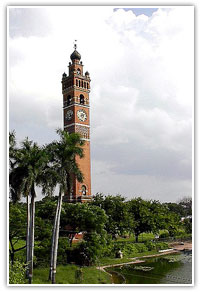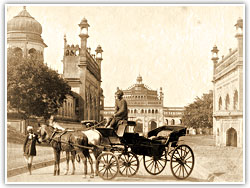|
|
Lucknow, Uttar Pradesh
.............................................................................................................................................................................. |
|
Information about Lucknow
Lucknow, the city of gardens is the capital of
Uttar Pradesh. This city is also known as the
golden city of east and one of the finest cities
of India. Lucknow derives its name from Lakshman,
the Lord Rama’s younger brother. Lucknow is
situated at an alitude of 123 meters above the sea
level on the banks of the Gomti river in the heart
of eastern UP and surrounded by the unrelentingly
flat Gangetic plain. Lucknow was the principal
centre of the erstwhile Awadh province. Even while
keeping pace with modern developments, Lucknow has
preserved its golden past and its sublime culture
– the Lucknawi Tehzib. Lucknow has also been the
home of various poets and writers of Hindu-urdu
literature, dance, music and delicious cuisine.
The fascinating ‘Chikankari’ or exquisite shadow
work embroidery on fine muslin cloth is also known
worldwide. Hindu, Urdu and English are the main
|
 |
|
|
languages which are spoken in Lucknow. The best season
to visit Lucknow is from October to March.
History of Lucknow
The Lucknow witnessed the rise and fall of many
dynasties. When the Mughals conquered North India in the
16th century it was absorbed into their empire and
rapidly developed under Akbar’s patronage. In the 18th
century, Nawab Sadat Ali Khan founded the Oudh (Awadh)
dynasty. The builder of Lucknow was Nawab Asif-ud-Daula
who shifted his capital here from Faizabad in 1775 and
shaped it into a city of gardens and great buildings
like the Great Imambara. He also emptied the regal
coffers with his ambitious building and personal
extravagance. The rulers of Oudh were great connoisseurs
of music and poetry. It remained a center of political
and cultural activities. In the mid 1850, under Lord
Dalhousie, the British annexed a number of Indian
states. The Lord Dalhousie considered British rule
so
superior to Indian that
the more territory directly administered by the British
the better it would be for the Indian people. He
therefore evolved a policy of lapse whereby the states
of Indian princes without direct heirs could be taken
over on the ruler’s death. Chronic mismanagement was
also the main cause for takeover. The great Muslim state
of Oudh was annexed for this second reason. The Oudh
dyansty also falls as the Nawab Wajid Ali Shah was so
engrossed in his game of chess that he remained
unheeding to his tasks even when British soldiers
occupied his capital. Whatever the justification, there
was considerable resentment against the British because
it was generally regarded as a breach of faith. A strong
British presence was established in the city and it
became a key administrative and military centre. In
1857, when the mutiny broke, Sir Henry Lawrence gathered
the British community into the Residency which was
turned into a fortress. The ensureing siege lasted for
87 days. When the relieving force under sir Colin
Campbell finally broke through, the once splendid
Residency was a blackened ruins, its walls pockmarked
and gaping with cannon ball holes. Today it is a mute
witness to a desperate struggle.
Cuisine of Lucknow
Lucknow is also a gourmet’s city. ‘Lucknavi Parathas’
(unleavened bread) with 10 layers are soft and crisp.
Variety of Kababs, Dampukhta, Seenkh Kabab, Rumali Roti,
Kulcha Nahari, Biryani, Sheermal etc. are some of the
famous dishes of Lucknow. There are also various
restaurants and eating joints in Lucknow, where you can
have truly delicious Lakhnawi cuisine. The coffee shops,
pizza outlets and fast food joins are also available as
well.
Shopping in Lucknow
Lucknow is the home of the fascinating ‘Chikankari’ or
exquisite shadow work embroidery on fine mulin cloth,
perfumes (with a base of sandalwood oil, agar, saffron
and other herbs), zari (silver and gold thread
embroidery), clay toys, velvet slippers, block-printed
fabrics and glazed pottery. The Chikankari of Lucknow is
known all over the world. The craftsmanship of Lucknow
artist is unparallel in Zardozi, Kaamdani, and Mukesh
works. Sarees, Lehngas, Lanchas and Kurtas can be bought
from here. The main shopping areas in the city are
Hazratogaj, Aminabad, Janpath, Chowk, Nakkhas, Sadar and
Kapoorthala.
Festivals of Lucknow
Some of the major Hindu and Muslim festivals are
celebrated in Lucknow. There are also several festivals
celebrated distinctively in Lucknow. The day after
Diwali is celebrated with a great fair and national kite
flying competition at the Patang Park. In the month of
February, the UP Government organizes the Lucknow
festival. Song, drama, dance, processions, boating, ekka
races are the main features of the ten day festival with
special emphasis on the performance of Indian classical
music. Moharram is another festival which is celebrated
in Lucknow. This is really not a festival but a period
of mourning when huge tazias (replicas of tombs of the
son-inlsaw and grandsons of the Prophet) are taken out
in procession by Shia Muslims amidst beating of breasts.
The pageantry of the Nawabi days is re-enacted.
Fire-walking takes place on one of the nights. |
|
|
|
Tourist Attractions
in Lucknow
There are various majestic monuments and buildings
in Lucknow, which speak of its glorious past. Bara
Imambara, Hussainabad Imambara, Rumi Darwaza,
Lakshman Tila, Picture Gallery, Dilkusha Kothi,
Chowk, The Residency, Dr. Bhim Rao Ambedkar
Memorial and State Museum are the main tourist
attractions in Lucknow. The main attraction of
Lucknow is the Bara (Big) Imambara, also known as
Asafi Imambara. It was built by Nawab
Asif-ud-Daula in 1784 and one of the
|
 |
|
|
architectural wonders of Lucknow. The Rumi Darwaza is
the massive gateway of the Bara Imambara. Hussainabad
Imambara, also known as the Chotta (small) Imambara
houses the tombs of Muhammad Ali Shah and his mother.
This Imambara was built by Muhammad Ali Shah in a florid
Saracenic style with a dome, turrets and minarets.
More....
How to reach Lucknow
By Air:
Lucknow is directly connected by Indian Airlines flights
with Delhi, Patna, Kolkata, Gorakhpur, Mumbai, Kanpur
and Varanasi with regular flights. The Amousi airport is
about 14 km from the city centre.
By Rail:
Lucknow is on the trunk line and has direct rail
connections with Agra, Ahmedabad, Amritsar, Bomaby,
Cochin, Delhi, Gorakhpur, Jammu, Puri, Varanasi, etc.
The most convenienet connection from Delhi is Shatabdi
Express – which is air-conditioned.
By Road:
Lucknow is well connected by road with all major cities
of the country like Kanpur, Ayodhya, Allahabad, Varanasi,
Khajurhao, Agra and Delhi.
|
|
|
|